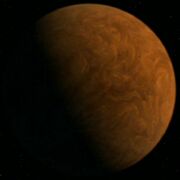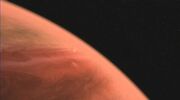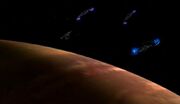(bot: ref templates) |
Renegade54 (talk | contribs) m (formatting, linkfix, + ext. link(s)) |
||
| Line 1: | Line 1: | ||
| − | [[Image:Gas giant.jpg|thumb|A |
+ | [[Image:Gas giant.jpg|thumb|A Class 7 gas giant]] |
| − | [[Image:QtahL class gas giant.jpg|thumb|A |
+ | [[Image:QtahL class gas giant.jpg|thumb|A Class 9 gas giant]] |
| − | [[Image:Class J gas giant.jpg|thumb|A |
+ | [[Image:Class J gas giant.jpg|thumb|A Class J gas giant]] |
| − | |||
A '''gas giant''' is a huge [[planet]] made entirely of base [[gas]]es, including [[fluorine]], [[methane]] and [[ammonia]]. Typically they do not posses a solid surface, but rather have dense [[atmosphere]]s. These turbulent atmospheres are generally made of the same materials as [[star]]s, however, they lack the mass necessary to begin [[nuclear fusion]]. Theoretically, if two gas giants collide, they may be able to create a self-sustaining fusion reaction, leading to the birth of a new star. ({{TNG|Ship in a Bottle}}) |
A '''gas giant''' is a huge [[planet]] made entirely of base [[gas]]es, including [[fluorine]], [[methane]] and [[ammonia]]. Typically they do not posses a solid surface, but rather have dense [[atmosphere]]s. These turbulent atmospheres are generally made of the same materials as [[star]]s, however, they lack the mass necessary to begin [[nuclear fusion]]. Theoretically, if two gas giants collide, they may be able to create a self-sustaining fusion reaction, leading to the birth of a new star. ({{TNG|Ship in a Bottle}}) |
||
| − | There are several types of gas giants known to [[ |
+ | There are several types of gas giants known to [[Human]]s: [[Class J planet|Class J]], [[Class 6 gas giant|Class 6]], [[Class 7 gas giant|Class 7]], and the [[Class 9 gas giant]], which is also known to the [[Klingon]]s as the [[Q'tahL class]]. ({{DS9|Starship Down}}; {{ENT|Broken Bow|Sleeping Dogs}}) The [[Sol system]] has four gas giants, none of which are Class 9. ({{ENT|Sleeping Dogs}}) |
Gas giants contain a lot of intense [[magnetic field]]s that often create unique waveform. The resulting [[EM interference]] sounds very strange when played over speakers. [[Travis Mayweather]] referred to these sounds as "[[siren calls]]," noting that while he lived aboard the [[ECS Horizon|ECS ''Horizon'']] as a kid, his dad would put them through the speakers whenever they flew by a gas giant. ({{ENT|Sleeping Dogs}}) |
Gas giants contain a lot of intense [[magnetic field]]s that often create unique waveform. The resulting [[EM interference]] sounds very strange when played over speakers. [[Travis Mayweather]] referred to these sounds as "[[siren calls]]," noting that while he lived aboard the [[ECS Horizon|ECS ''Horizon'']] as a kid, his dad would put them through the speakers whenever they flew by a gas giant. ({{ENT|Sleeping Dogs}}) |
||
| Line 11: | Line 10: | ||
In [[2152]], [[Enterprise (NX-01)|''Enterprise'']] pulled the [[IKS Somraw|IKS ''Somraw'']] from a Class J gas giant. ({{ENT|Sleeping Dogs|Marauders|Judgment}}) Later that year, they encountered a gas giant in [[Arkonian]] [[space]] that had "dozens of [[moon]]s," and was referred to as "like a [[gravity|gravitational]] [[jigsaw puzzle]]." ({{ENT|Dawn}}) The [[Xindi-Insectoid shuttle]] discovered in [[2153]] was discovered to have almost half of its [[power grid]] routed to [[structural integrity]], leading them to theorize that it could probably be flown inside a gas giant. ({{ENT|Hatchery|Azati Prime}}) |
In [[2152]], [[Enterprise (NX-01)|''Enterprise'']] pulled the [[IKS Somraw|IKS ''Somraw'']] from a Class J gas giant. ({{ENT|Sleeping Dogs|Marauders|Judgment}}) Later that year, they encountered a gas giant in [[Arkonian]] [[space]] that had "dozens of [[moon]]s," and was referred to as "like a [[gravity|gravitational]] [[jigsaw puzzle]]." ({{ENT|Dawn}}) The [[Xindi-Insectoid shuttle]] discovered in [[2153]] was discovered to have almost half of its [[power grid]] routed to [[structural integrity]], leading them to theorize that it could probably be flown inside a gas giant. ({{ENT|Hatchery|Azati Prime}}) |
||
| − | In the [[mirror universe]], the [[Tholian]]s held the |
+ | In the [[mirror universe]], the [[Tholian]]s held the {{USS|Defiant|NCC-1764}} at a facility in the [[Vintaak system]] that was orbiting the gas giant. ({{ENT|In a Mirror, Darkly}}) |
| − | In [[2369]], the |
+ | In [[2369]], the {{USS|Enterprise|NCC-1701-D|-D}} was able to witness the collision of two gas giants in the [[Detrian system]]. ({{TNG|Ship in a Bottle}}) |
| − | In [[2370]], the |
+ | In [[2370]], the {{USS|Raman}} became trapped in the atmosphere of a gas giant while the crew was attempting to sample it at a low orbit. ({{TNG|Interface}}) |
:''According to the script, the planet was "a huge, greenish, [[Neptune]]-like planet. The swirling, violent quality of its atmosphere can be seen even from [orbit]." |
:''According to the script, the planet was "a huge, greenish, [[Neptune]]-like planet. The swirling, violent quality of its atmosphere can be seen even from [orbit]." |
||
| Line 21: | Line 20: | ||
==Background== |
==Background== |
||
| − | According to [[Geoffrey Mandel]]'s ''[[Star Trek: Star Charts]]'', [[Starfleet]]'s [[planetary classification]] of gas giants are "class J" planets, ranging in age from 2 to 10 billion years. The diameter of a gas giant ranges from 50,000 |
+ | According to [[Geoffrey Mandel]]'s ''[[Star Trek: Star Charts]]'', [[Starfleet]]'s [[planetary classification]] of gas giants are "class J" planets, ranging in age from 2 to 10 billion years. The diameter of a gas giant ranges from 50,000 kilometers to 140,000 kilometers, and its [[atmosphere]] is layered with various gases, at different densities and temperatures. Gas giants usually lie in the cold zone of a [[star]]'s ecosphere, and have been known to host [[hydrocarbon]]-based indigenous [[lifeform]]s. |
| + | ==External link== |
||
| + | *{{wikipedia}} |
||
[[Category:Astronomical objects]] |
[[Category:Astronomical objects]] |
||
[[de:Gasriese]] |
[[de:Gasriese]] |
||
Revision as of 18:22, 16 November 2007

A Class 7 gas giant

A Class 9 gas giant

A Class J gas giant
A gas giant is a huge planet made entirely of base gases, including fluorine, methane and ammonia. Typically they do not posses a solid surface, but rather have dense atmospheres. These turbulent atmospheres are generally made of the same materials as stars, however, they lack the mass necessary to begin nuclear fusion. Theoretically, if two gas giants collide, they may be able to create a self-sustaining fusion reaction, leading to the birth of a new star. (TNG: "Ship in a Bottle")
There are several types of gas giants known to Humans: Class J, Class 6, Class 7, and the Class 9 gas giant, which is also known to the Klingons as the Q'tahL class. (DS9: "Starship Down"; ENT: "Broken Bow", "Sleeping Dogs") The Sol system has four gas giants, none of which are Class 9. (ENT: "Sleeping Dogs")
Gas giants contain a lot of intense magnetic fields that often create unique waveform. The resulting EM interference sounds very strange when played over speakers. Travis Mayweather referred to these sounds as "siren calls," noting that while he lived aboard the ECS Horizon as a kid, his dad would put them through the speakers whenever they flew by a gas giant. (ENT: "Sleeping Dogs")
In 2152, Enterprise pulled the IKS Somraw from a Class J gas giant. (ENT: "Sleeping Dogs", "Marauders", "Judgment") Later that year, they encountered a gas giant in Arkonian space that had "dozens of moons," and was referred to as "like a gravitational jigsaw puzzle." (ENT: "Dawn") The Xindi-Insectoid shuttle discovered in 2153 was discovered to have almost half of its power grid routed to structural integrity, leading them to theorize that it could probably be flown inside a gas giant. (ENT: "Hatchery", "Azati Prime")
In the mirror universe, the Tholians held the USS Defiant at a facility in the Vintaak system that was orbiting the gas giant. (ENT: "In a Mirror, Darkly")
In 2369, the USS Enterprise-D was able to witness the collision of two gas giants in the Detrian system. (TNG: "Ship in a Bottle")
In 2370, the USS Raman became trapped in the atmosphere of a gas giant while the crew was attempting to sample it at a low orbit. (TNG: "Interface")
- According to the script, the planet was "a huge, greenish, Neptune-like planet. The swirling, violent quality of its atmosphere can be seen even from [orbit]."
In 2371, a Maquis interceptor, piloted by the Female Changeling, lured a runabout, piloted by Kira Nerys and Odo, to a moon orbiting the gas giant located near the Badlands. (DS9: "Heart of Stone")
Background
According to Geoffrey Mandel's Star Trek: Star Charts, Starfleet's planetary classification of gas giants are "class J" planets, ranging in age from 2 to 10 billion years. The diameter of a gas giant ranges from 50,000 kilometers to 140,000 kilometers, and its atmosphere is layered with various gases, at different densities and temperatures. Gas giants usually lie in the cold zone of a star's ecosphere, and have been known to host hydrocarbon-based indigenous lifeforms.
